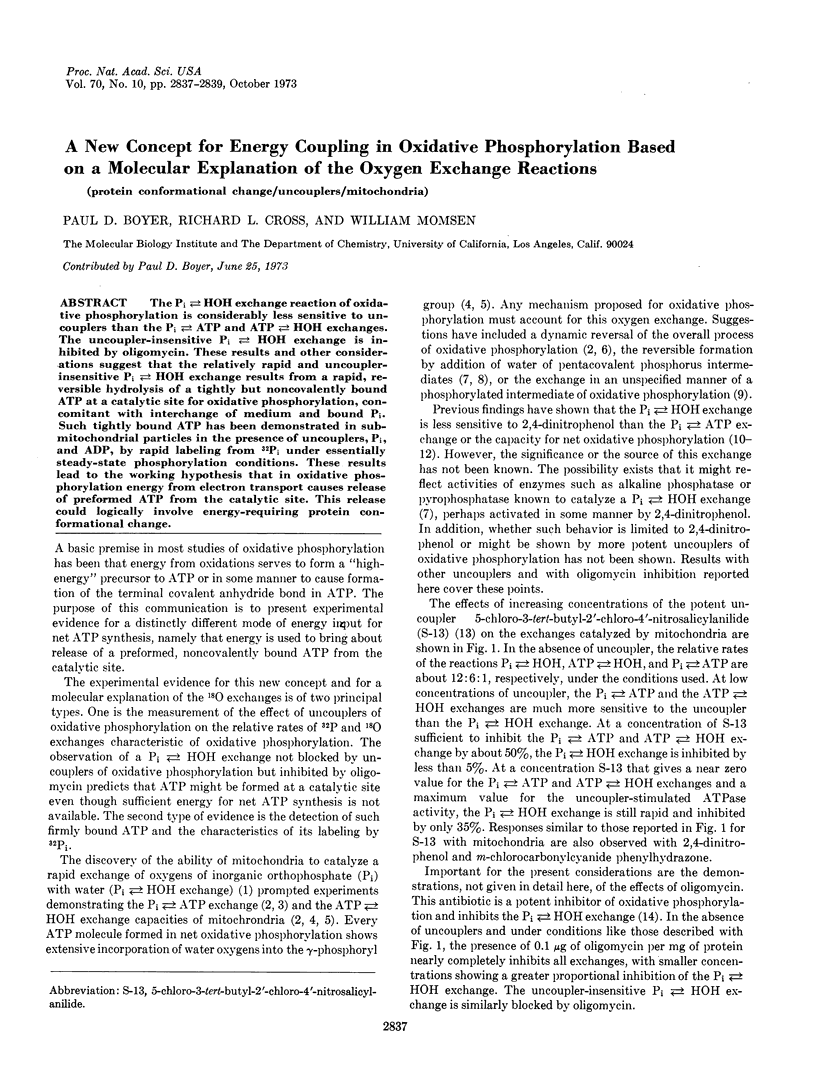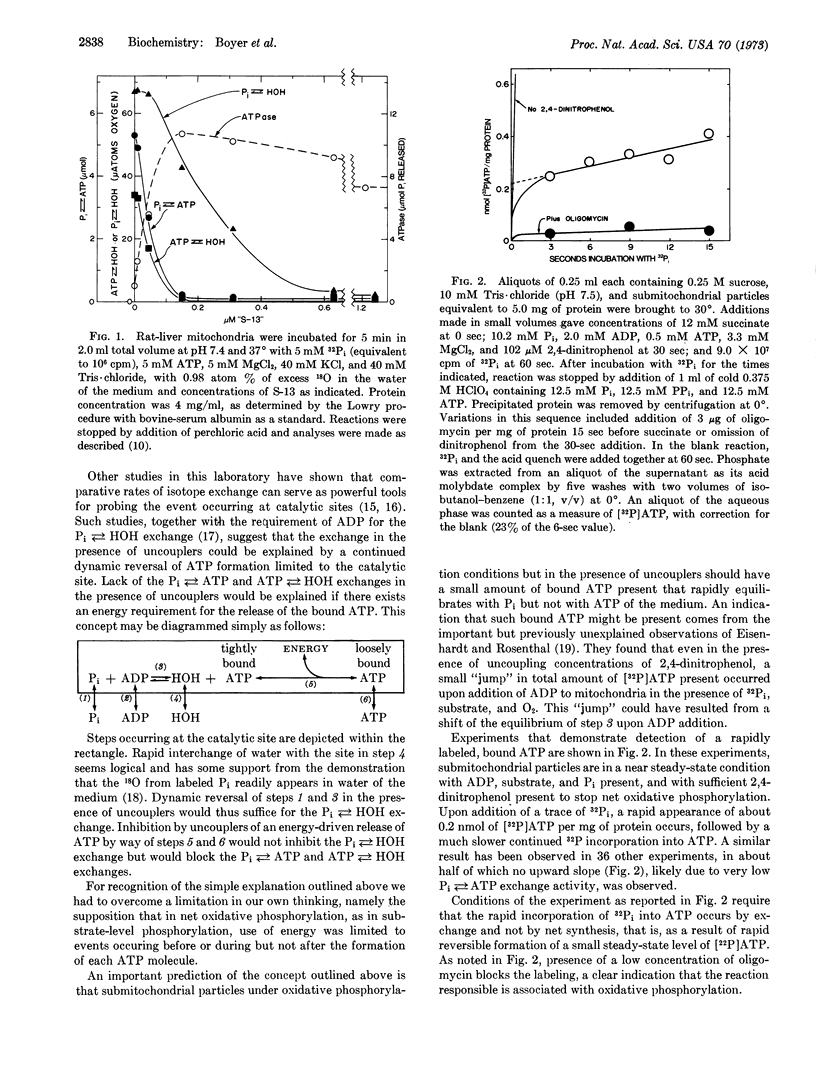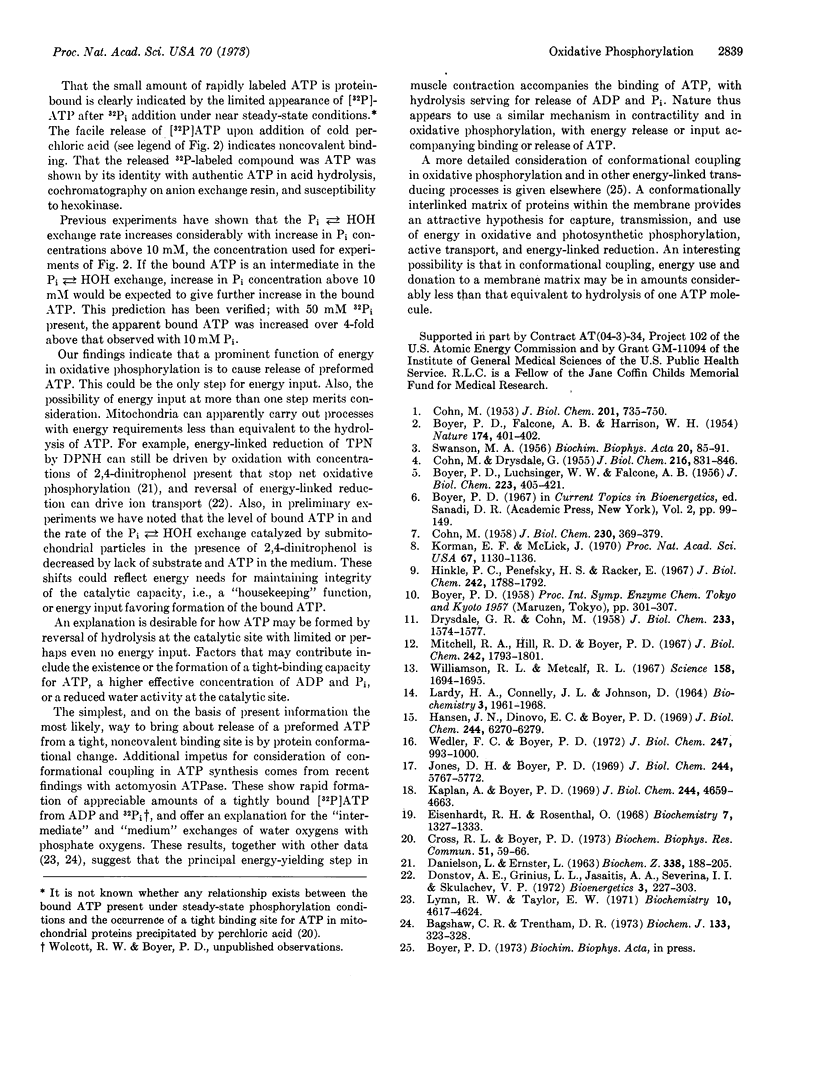Abstract
The Pi ⇄ HOH exchange reaction of oxidative phosphorylation is considerably less sensitive to uncouplers than the Pi ⇄ ATP and ATP ⇄ HOH exchanges. The uncoupler-insensitive Pi ⇄ HOH exchange is inhibited by oligomycin. These results and other considerations suggest that the relatively rapid and uncoupler-insensitive Pi ⇄ HOH exchange results from a rapid, reversible hydrolysis of a tightly but noncovalently bound ATP at a catalytic site for oxidative phosphorylation, concomitant with interchange of medium and bound Pi. Such tightly bound ATP has been demonstrated in submitochondrial particles in the presence of uncouplers, Pi, and ADP, by rapid labeling from 32Pi under essentially steady-state phosphorylation conditions. These results lead to the working hypothesis that in oxidative phosphorylation energy from electron transport causes release of preformed ATP from the catalytic site. This release could logically involve energy-requiring protein conformational change.
Keywords: protein conformational change, uncouplers, mitochondria
Full text
PDF


Selected References
These references are in PubMed. This may not be the complete list of references from this article.
- BOYER P. D., FALCONE A. B., HARRISON W. H. Reversal and mechanism of oxidative phosphorylation. Nature. 1954 Aug 28;174(4426):401–402. doi: 10.1038/174401b0. [DOI] [PubMed] [Google Scholar]
- BOYER P. D., FALCONE A. B., LUCHSINGER W. W. O18 and P32 exchange reactions of mitochondria in relation to oxidative phosphorylation. J Biol Chem. 1956 Nov;223(1):405–421. [PubMed] [Google Scholar]
- Bagshaw C. R., Trentham D. R. The reversibility of adenosine triphosphate cleavage by myosin. Biochem J. 1973 Jun;133(2):323–328. doi: 10.1042/bj1330323. [DOI] [PMC free article] [PubMed] [Google Scholar]
- COHN M. A study of oxidative phosphorylation with O18-labeled inorganic phosphate. J Biol Chem. 1953 Apr;201(2):735–750. [PubMed] [Google Scholar]
- COHN M., DRYSDALE G. R. A study with O18 of adenosine triphosphate formation in oxidative phosphorylation. J Biol Chem. 1955 Oct;216(2):831–846. [PubMed] [Google Scholar]
- Cross R. L., Boyer P. D. Evidence for detection of AT 32 P bound at the coupling sites of mitochondrial oxidative phosphorylation. Biochem Biophys Res Commun. 1973 Mar 5;51(1):59–66. doi: 10.1016/0006-291x(73)90507-x. [DOI] [PubMed] [Google Scholar]
- DANIELSON L., ERNSTER L. ENERGY-DEPENDENT REDUCTION OF TRIPHOSPHOPYRIDINE NUCLEOTIDE BY REDUCED DIPHOSPHOPYRIDINE NUCLEOTIDE, COUPLED TO THE ENERGY-TRANSFER SYTEM OF THE RESPIRATORY CHAIN. Biochem Z. 1963;338:188–205. [PubMed] [Google Scholar]
- DRYSDALE G. R., COHN M. On the mode of action of 2, 4-dinitrophenol in uncoupling oxidative phosphorylation. J Biol Chem. 1958 Dec;233(6):1574–1577. [PubMed] [Google Scholar]
- Dontsov A. E., Grinius L. L., Jasaitis A. A., Severina I. I., Skulachev V. P. A study on the mechanism of energy coupling in the redox chain. I. Transhydrogenase: the fourth site of the redox chain energy coupling. J Bioenerg. 1972 Jun;3(3):277–303. doi: 10.1007/BF01515975. [DOI] [PubMed] [Google Scholar]
- Eisenhardt R. H., Rosenthal O. Studies on energy transfer in mitochondrial oxidative phosphorylation. 3. On the interaction of adenosine diphosphate with high-energy intermediates. Biochemistry. 1968 Apr;7(4):1327–1333. doi: 10.1021/bi00844a012. [DOI] [PubMed] [Google Scholar]
- Hansen J. N., Dinovo E. C., Boyer P. D. Initial and equilibrium 18O, 14C, 3H, and 2H exchange rates as probes of the fumarase reaction mechanism. J Biol Chem. 1969 Nov 25;244(22):6270–6279. [PubMed] [Google Scholar]
- Hinkle P. C., Penefsky H. S., Racker E. Partial resolution of the enzymes catalyzine oxidative phosphorylation. XII. The H-2-18-O-inorganic phosphate and H-2-18-O-adenosine triphosphate exchange reactions in submitochondrial particles from beef heart. J Biol Chem. 1967 Apr 25;242(8):1788–1792. [PubMed] [Google Scholar]
- Jones D. H., Boyer P. D. The apparent absolute requirement of adenosine diphosphate for the inorganic phosphate--water exchange of oxidative phosphorylation. J Biol Chem. 1969 Nov 10;244(21):5767–5772. [PubMed] [Google Scholar]
- Kaplan A., Boyer P. D. Exchange and localization of 3H and 180 from water and substrates by mitochondria. J Biol Chem. 1969 Sep 10;244(17):4659–4663. [PubMed] [Google Scholar]
- Korman E. F., McLick J. A dynamic stereochemical reaction mechanism for the ATP synthesis reaction of mitochondrial oxidative phosphorylation. Proc Natl Acad Sci U S A. 1970 Nov;67(3):1130–1136. doi: 10.1073/pnas.67.3.1130. [DOI] [PMC free article] [PubMed] [Google Scholar]
- LARDY H. A., CONNELLY J. L., JOHNSON D. ANTIBIOTIC STUDIES. II. INHIBITION OF PHOSPHORYL TRANSFER IN MITOCHONDRIA BY OLIGOMYCIN AND AUROVERTIN. Biochemistry. 1964 Dec;3:1961–1968. doi: 10.1021/bi00900a030. [DOI] [PubMed] [Google Scholar]
- Lymn R. W., Taylor E. W. Mechanism of adenosine triphosphate hydrolysis by actomyosin. Biochemistry. 1971 Dec 7;10(25):4617–4624. doi: 10.1021/bi00801a004. [DOI] [PubMed] [Google Scholar]
- Mitchell R. A., Hill R. D., Boyer P. D. Mechanistic implications of Mg++, adenine nucleotide, and inhibitor effects on energy-linked reactions of submitochondrial particles. J Biol Chem. 1967 Apr 25;242(8):1793–1801. [PubMed] [Google Scholar]
- SWANSON M. A. Studies on the non-oxidative exchange between inorganic phosphate and ATP, as catalyzed by intact mitochondria. Biochim Biophys Acta. 1956 Apr;20(1):85–91. doi: 10.1016/0006-3002(56)90266-9. [DOI] [PubMed] [Google Scholar]
- Wedler F. C., Boyer P. D. Action patterns of feedback modifiers on equilibrium exchanges and applications to glutamine synthetase (Escherichia coli W). J Biol Chem. 1972 Feb 25;247(4):993–1000. [PubMed] [Google Scholar]
- Williamson R. L., Metcalf R. L. Salicylanilides: a new group of active uncouplers of oxidative phosphorylation. Science. 1967 Dec 29;158(3809):1694–1695. doi: 10.1126/science.158.3809.1694. [DOI] [PubMed] [Google Scholar]


